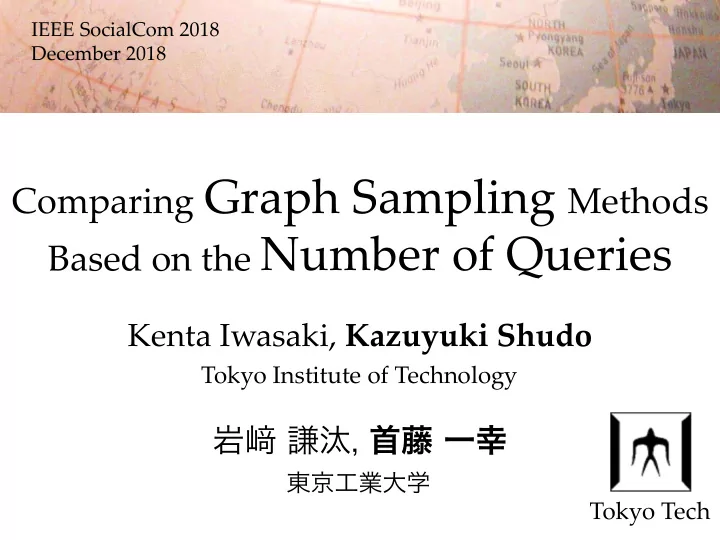

東京工業大学 岩﨑 謙汰, 首藤 一幸 IEEE SocialCom 2018 December 2018 Comparing Graph Sampling Methods Based on the Number of Queries Kenta Iwasaki, Kazuyuki Shudo Tokyo Institute of Technology Tokyo Tech
1 / 10 Graph sampling ⊃ Crawling ⊃ Random walk • They enable estimation of nodal and topological properties of online social networks (OSNs) – Effective because the entire network is not available. – Properties: Degree distribution, clustering coefficient, … – Note: Crawling (e.g. random walk) is possible but uniform sampling is not. A query with Crawling on OSN Node ID Sample node list Neighbor (friend) list [1, 2, 4, 2, 7, …] • Query can be the bottleneck of the sampling performance due to – API limits – Communication latency is much larger than computation.
2 / 10 Contribution: Query number standard • Problem – Sample size has been the standard to evaluate graph sampling techniques. Standards in studies Length of [Rasti 2009] sample node list [Riberio 2010] (walk length) [Lee 2012] Length of Fig. 4 in [Lee 2012] [Hardiman 2013] sample node list ??? # of samples Number of [Gjoka 2011] • Contribution sample nodes – Query number based comparison shows different relative merits for sampling and estimation techniques. – It reflects graph accessing cost better.
3 / 10 Graph sampling techniques • Random walk ‐ based techniques are effective for property estimation for OSNs – They enable unbiased sampling with Markov chain analysis. • Our targets – SRW ‐ rw : Simple random walk w/ re ‐ weighting – NBRW ‐ rw : Non ‐ backtracking random walk w/ re ‐ weighting – MHRW : Metropolis ‐ Hastings random walk 1 1 1 4 4 1/2 4 1/2 3 1/3 3 3 1/2 1/3 x 2 1/3 = 1/degree 0 2 2 1/3 Previous node 1/6 SRW: MHRW: NBRW: Simple Non ‐ backtracking Metropolis ‐ Hastings random walk random walk random walk
4 / 10 Sample size vs. query number • Very different Sample size (length of sample node list) by 10,000 queries Simple Non ‐ backtracking Metropolis ‐ Hastings Graphs are in Stanford Large Network Dataset Collection • Rationale: MHRW can stay the same node and the length of sample node list grows without a query. • Note that not only the sample size determines estimation efficiency. E.g. NBRW reaches various nodes and it is better with Counting Triangles [Iwasaki 2018].
5 / 10 Query issuing timings 1. For random walk – When getting neighbor (friend) list of the next hop 2. For property estimation – Depends on each estimation technique – E.g. When getting neighbor (friend) list of multiple neighbor nodes of a node to calculate clustering coefficient of the node naively. 1 4 3 Target 2 It is necessary to know how the neighbor nodes connected each other to calculate cluster coefficient.
6 / 10 Experiments with sample size and query number standards • Clustering coefficient estimated • Estimation efficiency (precision / cost) compared on 1. Estimation techniques: Naïve method vs. Counting Triangles [Hardiman 2013] Counting Triangle does not require additional queries for property estimation. 2. Sampling (random walk) techniques: SRW vs. NBRW vs. MHRW Graph # of nodes Average degree Average Clust. Coeff. Amazon 334,863 5.530 0.3967 DBLP 317,080 6.622 0.6324 Gowalla 196,591 9.668 0.2367 in Stanford Large Network Dataset Collection
7 / 10 Naïve method vs. Counting Triangles [Hardiman 2013] • Sampling with simple random walk ( SRW ) • Relative merits are reversed. – The similar results shown with the other networks. Better Reversed Query number Sample size
8 / 10 SRW vs. NBRW vs. MHRW • Estimating with Counting Triangles • Margins are much narrowed. Better Narrow Sample size Query number • Note: Our contribution includes Counting Triangles with MHRW.
9 / 10 SRW vs. NBRW vs. MHRW • Estimating with Counting Triangles • Relative merits are reversed for DBLP graph. Better Reversed Sample size Query number
10 / 10 Summary • Query number standard Cf. sample size standard – for comparing graph sampling techniques – for comparing property estimation techniques – It reflects graph accessing cost better. •Accessing online social networks •Accessing a graph on storage and memory • The two standards showed different relative merits for techniques. Tokyo Tech
Recommend
More recommend